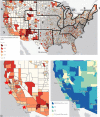Community-level social vulnerability and individual socioeconomic status on liver transplant referral outcome
- PMID: 37378636
- PMCID: PMC10309511
- DOI: 10.1097/HC9.0000000000000196
Community-level social vulnerability and individual socioeconomic status on liver transplant referral outcome
Abstract
Background: Recent endeavors emphasize the importance of understanding early barriers to liver transplantation (LT) by consistently collecting data on patient demographics, socioeconomic factors, and geographic social deprivation indices.
Methods: In this retrospective single-center cohort study of 1657 adults referred for LT evaluation, we assessed the association between community-level vulnerability and individual socioeconomic status measures on the rate of waitlisting and transplantation. Patients' addresses were linked to Social Vulnerability Index (SVI) at the census tract-level to characterize community-level vulnerability. Descriptive statistics were used to describe patient characteristics. Multivariable cause-specific HRs were used to assess the association between community-level vulnerability, individual measures of the socioeconomic status, and LT evaluation outcomes (waitlist and transplantation).
Results: Among the 1657 patients referred for LT during the study period, 54% were waitlisted and 26% underwent LT. A 0.1 increase in overall SVI correlated with an 8% lower rate of waitlisting (HR 0.92, 95% CI 0.87-0.96, p < 0.001), with socioeconomic status, household characteristics, housing type and transportation, and racial and ethnic minority status domains contributing significantly to this association. Patients residing in more vulnerable communities experienced a 6% lower rate of transplantation (HR 0.94, 95% CI 0.91- 0.98, p = 0.007), with socioeconomic status and household characteristic domain of SVI significantly contributing to this association. At the individual level, both government insurance and employment status were associated with lower rates of waitlisting and transplantation. There was no association with mortality prior to waitlisting or mortality while on the waitlist.
Conclusion: Our findings indicate that both individual and community measures of the socioeconomic status (overall SVI) are associated with LT evaluation outcomes. Furthermore, we identified individual measures of neighborhood deprivation associated with both waitlisting and transplantation.
Copyright © 2023 The Author(s). Published by Wolters Kluwer Health, Inc. on behalf of the American Association for the Study of Liver Diseases.
Conflict of interest statement
The authors have no conflicts to report.
The data that support the findings of this study are available on request from the corresponding author. The data are not publicly available due to privacy and ethical considerations.



